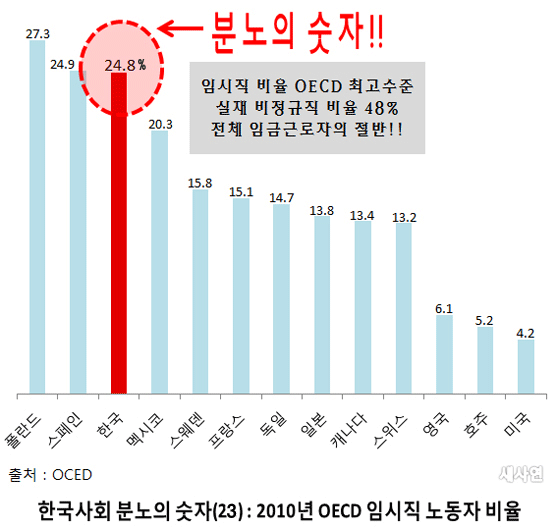한국은 OECD국가중 가장 빠르게 노령화되고 있는 나라라는 것은 놀랍지도 않습니다.Birth rates have plummeted, while the population is the fastest-aging among OECD countries. 미국처럼 이민정책으로 체울수도 없고, 아이를 더 낳게할수 있는 사회도 아니고, 당장 방법이 안보이는 사회입니다. 5포세대 추세까지 겹치면 현재 출산율 1.19란 숫자도 아주 낙관적인 숫자라고 보여집니다. 박근혜가 대통령이 된후 잠시 출산지원 정책으로 반짝한 것일뿐 1.1도 어렵다고 각됩니다.
이런 추세로 가게되면 2750년에 한국 사람은 자연적으로 지구에서 없어질 거라고 합니다. 국민연금처럼 이런 계산은 예상보다 더 빨리 다가올것입니다.


Korea should face its demographic crisis head on
http://www.brookings.edu/blogs/up-front/posts/2015/06/18-korea-faces-demographic-crisis-moon
Katharine (Kathy) H.S. Moon is the inaugural holder of the SK-Korea Foundation Chair in Korea Studies and senior fellow at the Brookings Center for East Asia Policy Studies. She also is a professor of Political Science at Wellesley College and holds the Edith Stix Wasserman Chair of Asian Studies. Moon’s research includes the U.S.-Korea alliance, politics of East Asia, inter-Korean relations, socio-political changes in both Koreas, as well as democratization, women and gender politics, and comparative social movements in East Asia. She received her B.A., magna cum laude, from Smith College and a Ph.D. from Princeton University, Department of Politics.
---------------------
http://newspeppermint.com/2015/06/22/southkoreaextinct/
한국은 2750년에 사라질지도 모릅니다
2015년 6월 23일 | By: arendt | 건강, 세계, 한국 | 2개의 댓글
많은 선진국이 인구 문제에 직면하고 있습니다. 하지만 이 중에서도 상황이 가장 심각한 건 한국입니다. 인구 고령화가 진행되는 것뿐만 아니라 출산율은 계속 감소하고 여성들이 결혼을 점점 하지 않으려 합니다. 2013년 한국의 출산율은 한국 역사상 가장 낮은 수준을 기록했습니다: 인구 1천 명당 고작 8.6명의 아이가 태어났습니다. 게다가 브루킹스 연구소의 보고서를 보면 9~24세 여성을 대상으로 한 정부 설문조사에서 45.6%만이 인생에서 반드시 결혼을 해야 한다고 답했습니다.
전반적으로 한국의 여성은 평생 1.187명의 아이를 출산할 것으로 예상하는데, 이는 전 세계에서 다섯 번째로 낮은 수준입니다. 브루킹스 연구소 보고서는 2014년 한국 의회의 분석을 언급하면서 “만약 출산율이 여성 한 명당 1.19명으로 유지되고 북한과의 통일이 이루어지지 않고 또 대규모 이민이 없는 한 한국은 2750년에 자연스럽게 없어질 것”이라고 보고했습니다. 의회 보고서의 시뮬레이션을 따르면, 현재 5,020만 명인 한국의 인구는 2100년이 되면 2천만 명으로 감소합니다. 두 번째로 큰 도시인 부산은 이 추세대로라면 2413년에 사라지고 수도 서울은 2505년에 사라지게 됩니다.
물론 이 예상은 735년 뒤의 일이라는 것을 명심할 필요가 있습니다. 따라서 많은 불확실성이 있고 그 사이에 한국의 인구 구조 변화에 긍정적으로 혹은 부정적으로 영향을 미치는 많은 변수가 개입할 수 있습니다. 또 한 가지 우리가 생각해야 할 것은 바로 다문화 가정입니다. 일반적으로 한국인 남성과 베트남이나 중국 출신 여성이 결혼한 가정의 출산율은 한국 여성이 이룬 가정의 출산율보다 높습니다. 2006~2014년 다문화 가정 출신 취학 연령대 어린이는 일곱 배 증가했습니다. 그리고 다문화 가정 출신 성인은 2013~2014년에만 21%가 증가했습니다.
이민자가 증가하는 것은 2016~2017년에 정점에 이를 한국 노동 시장에 희소식입니다. 지난해 12월 한국 경제 연구소가 발표한 보고서는 감소하는 노동 인구를 대체하고 경제 성장을 지속시키기 위해서는 현재 인구의 1/3에 해당하는 1,500만 명 정도의 이민자가 필요하다고 결론 내리고 있습니다. 그리고 한 가지 문화적 측면에서 흥미로운 점은 2005~2010년만 하더라도 “한국인이 되기 위해서는 한국 혈통이 중요하다”고 대답한 사람이 80%에 달했지만, 이 숫자는 2013년에 65.8%로 떨어졌다는 사실입니다. (비즈니스 인사이더)
---------------------
Many developed economies are facing demographic problems. But one case that stands out is South Korea.
Not only is the population aging (like in Japan and the US), but birthrates are also falling and women are increasingly less inclined to get married.
In 2013, the country's birth rate plummeted to the lowest level on record: Only 8.6 babies per 1,000 South Koreans were born, and the total number of births fell by 9.9% to the second-lowest number on record.
Furthermore, a government survey of respondents aged 9 to 24 showed that only 45.6% of women "said marriage was something they should do in life," considerably lower than the 62.9% of men, according to the Brookings Institute.
Overall, the average South Korean woman is expected to give birth to 1.187 babies in her lifetime — the fifth lowest fertility in the world.
"A 2014 study commissioned by the national legislature concluded that South Koreans could 'face natural extinction by 2750 if the birthrate were maintained at 1.19 children per woman — assuming no reunification with North Korea or significant inflow of migrants," according to the Brookings Institute, citing data from a simulation commissioned by the National Assembly in Seoul.

According to that simulation, South Korea's current population of 50.2 million could fall to 20 million by the end of the century. The second-largest city, Busan, will "go extinct" by 2413, while the capital, Seoul, will go by 2505.
It is important to keep in mind that this is a demographic forecast 735 years into the future, so — to keep it simple — there is a lot of uncertainty in the projections and there will definitely be other variables that affect South Korea's demographics positively and negatively.
However, there is another factor to consider: "mixed ethnic families" — in which one parent is Korean (usually the father) and the other is not (usually the mother, from China, Vietnam or the Philippines).
Notably, the birthrate for children of immigrant mothers is higher than that of native Korean women. The number of school-age children from "mixed ethnic families" went up seven times from 2014 to 2006, and the number of adolescents from "mixed ethnic families" increased by 21% from 2013 to 2014.
Read more: http://www.businessinsider.com/south-koreans-could-be-extinct-by-2750-2015-6#ixzz3eHmdWznp
---------------------












































































